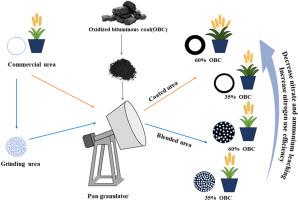氧化烟煤改性尿素:包衣与掺混对小麦生长特性及氮素利用效率的影响。
IF 5.7
2区 生物学
Q1 PLANT SCIENCES
引用次数: 0
摘要
传统尿素肥料的氮淋溶是一个主要的环境问题,降低了钙质土壤中氮的利用效率。我们假设用氧化烟煤(OBC)改性尿素可以产生一种缓释肥料,有效地减少氮淋溶,提高氮肥利用效率。因此,本研究旨在生产和评价涂层和混合obc -尿素配方。在温室条件下,以包膜(C1, C2)和混合(B1, B2)形式测试了两种OBC:尿素比(60:40和35:65),每种氮肥用量分别为推荐氮肥用量的100% (H;较高速率)和60% (L;较低速率)。与常规尿素相比,所有基于obc的处理都显著降低了硝态氮和铵态氮的浸出,其中C1H处理的硝态氮和铵态氮的浸出率最高,分别为46.33%和53.08%。含obc肥料也显著提高了NUE指数。其中,C1H处理使氮素利用率和氮素吸收效率(NUpE)分别比商品尿素提高33.35%和28.53%。C1H处理提高了地上部吸氮量(28.42%)、总叶绿素含量(33.88%)、总蛋白质含量(24.19%)、地上部鲜重(10.63%)、叶面积指数(29.01%)和穗数(32.15%)。值得注意的是,C1L处理仅施用推荐氮量的60%,保持了与全速率商用尿素相当的生长和养分吸收水平,同时提供了优越的氮肥利用效率。这些结果表明,obc包覆尿素可以减少氮淋溶,在不影响植物生长的情况下降低施肥量。本研究为钙质土壤植物与氮的相互作用提供了新的认识,并为可持续氮管理策略的发展提供了支持。本文章由计算机程序翻译,如有差异,请以英文原文为准。

Oxidized bituminous coal-modified urea: Coating versus blending effects on growth characteristics and nitrogen use efficiency in wheat
Nitrogen leaching from conventional urea fertilizers is a major environmental concern and reduces nitrogen use efficiency in calcareous soils. We postulated that modifying urea with oxidized bituminous coal (OBC) would create a slow-release fertilizer, effectively reducing nitrogen leaching and enhancing NUE. This study therefore aimed to produce and evaluate coated and blended OBC-urea formulations. Two OBC:urea ratios (60:40 and 35:65) were tested in coated (C1, C2) and blended (B1, B2) forms under greenhouse conditions, each applied at 100 % (H; Higher rate) and 60 % (L; Lower rate) of the recommended nitrogen rate. Compared to conventional urea, all OBC-based treatments significantly reduced nitrate and ammonium leaching, with the C1H treatment achieving the highest reductions: 46.33 % for nitrate and 53.08 % for ammonium. The OBC-containing fertilizers also significantly enhanced NUE indices. In particular, the C1H treatment led to increases of 33.35 % and 28.53 % in NUE and nitrogen uptake efficiency (NUpE), respectively, relative to commercial urea. Moreover, C1H improved shoot nitrogen uptake (28.42 %), total chlorophyll content (33.88 %), total protein (24.19 %), shoot fresh weight (10.63 %), leaf area index (29.01 %), and spike number (32.15 %). Remarkably, the C1L treatment, applied at only 60 % of the recommended nitrogen rate, maintained comparable growth and nutrient uptake levels to full-rate commercial urea, while providing superior NUE. These results suggest that OBC-coated urea can reduce nitrogen leaching and enable lower application rates without compromising plant growth. Overall, this study provides new insights into plant–nitrogen interactions in calcareous soils and supports the development of sustainable nitrogen management strategies.
求助全文
通过发布文献求助,成功后即可免费获取论文全文。
去求助
来源期刊
CiteScore
11.10
自引率
3.10%
发文量
410
审稿时长
33 days
期刊介绍:
Plant Physiology and Biochemistry publishes original theoretical, experimental and technical contributions in the various fields of plant physiology (biochemistry, physiology, structure, genetics, plant-microbe interactions, etc.) at diverse levels of integration (molecular, subcellular, cellular, organ, whole plant, environmental). Opinions expressed in the journal are the sole responsibility of the authors and publication does not imply the editors'' agreement.
Manuscripts describing molecular-genetic and/or gene expression data that are not integrated with biochemical analysis and/or actual measurements of plant physiological processes are not suitable for PPB. Also "Omics" studies (transcriptomics, proteomics, metabolomics, etc.) reporting descriptive analysis without an element of functional validation assays, will not be considered. Similarly, applied agronomic or phytochemical studies that generate no new, fundamental insights in plant physiological and/or biochemical processes are not suitable for publication in PPB.
Plant Physiology and Biochemistry publishes several types of articles: Reviews, Papers and Short Papers. Articles for Reviews are either invited by the editor or proposed by the authors for the editor''s prior agreement. Reviews should not exceed 40 typewritten pages and Short Papers no more than approximately 8 typewritten pages. The fundamental character of Plant Physiology and Biochemistry remains that of a journal for original results.

 求助内容:
求助内容: 应助结果提醒方式:
应助结果提醒方式:


